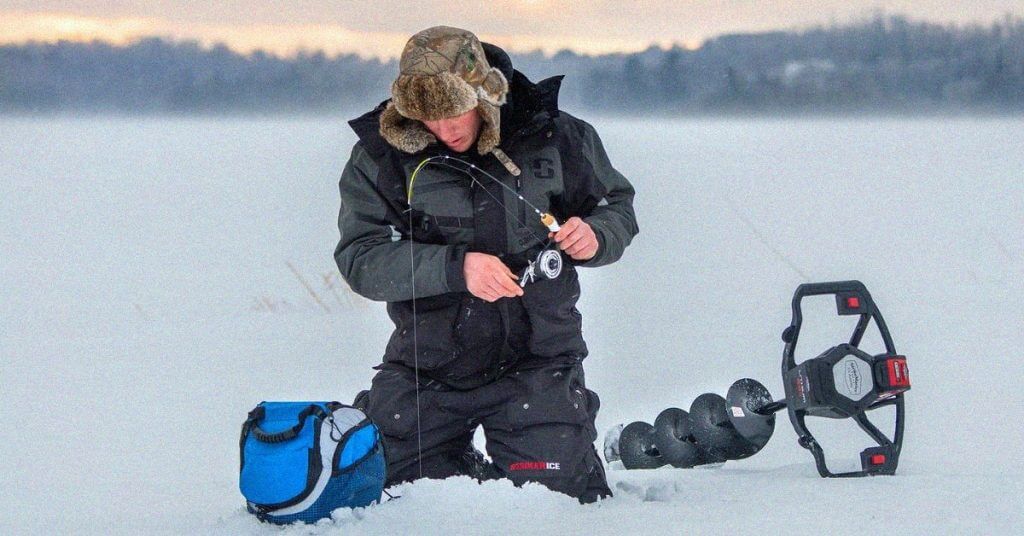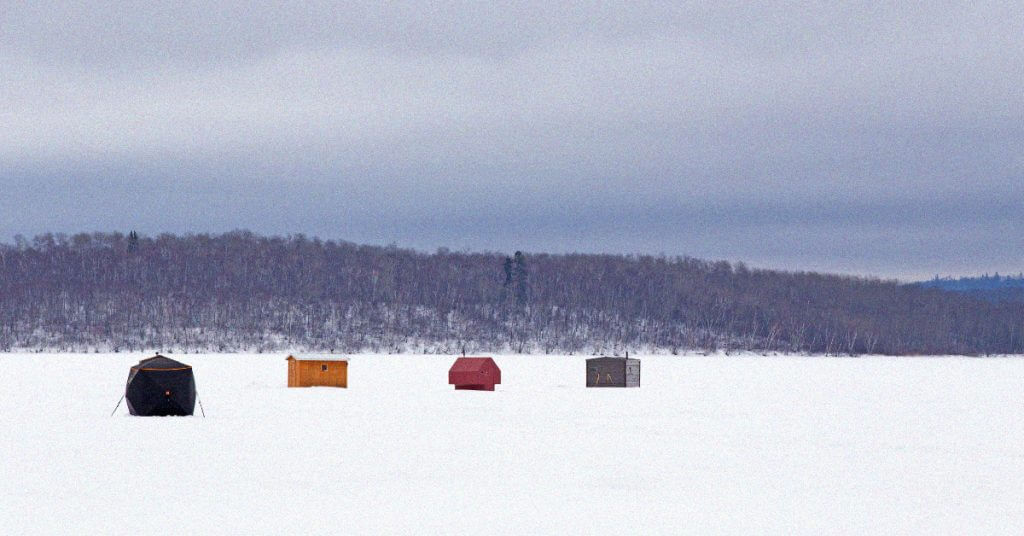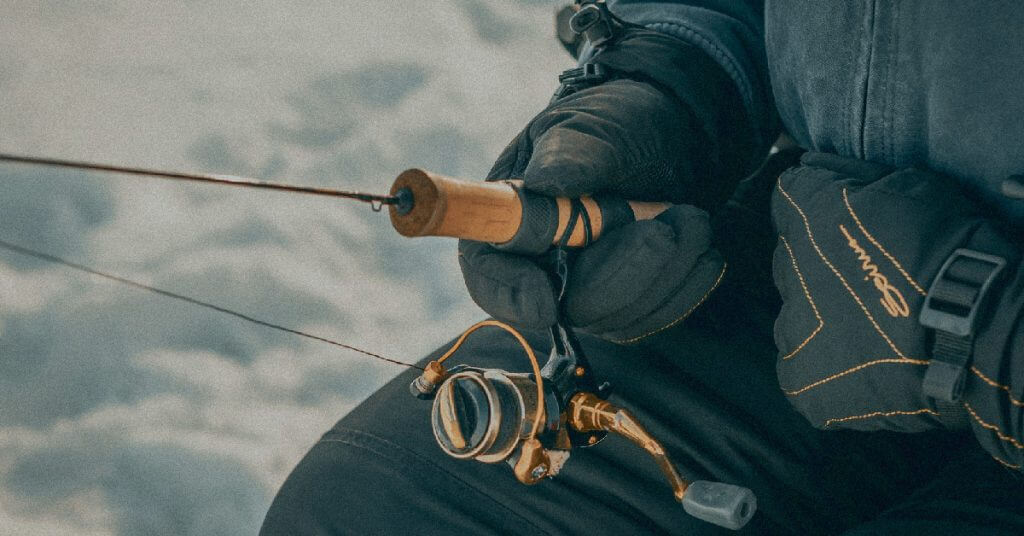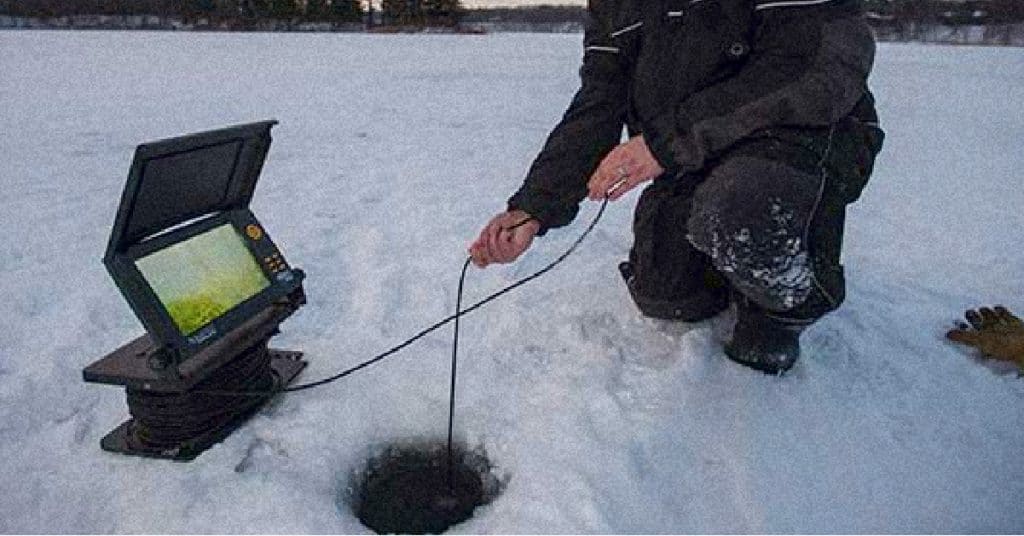That sudden snap of your line in -15°F wasn’t because of the cold – it’s about understanding how ice impacts your line’s visibility, abrasion resistance, and sensitivity.
After using 50+ lines over the years, I have identified the top nine that survive these brutal conditions.
Last updated: December 5th, 2025
Best Monofilament Lines
If you could choose one type of ice fishing line and use it perfectly for the rest of your life, it would have to be monofilament.
In my experience interacting with anglers of all ages and skill levels, mono remains the most popular choice – mainly because it’s the most available. What I love about it is the low memory, low weight, and better buoyancy compared to others.
Here are the only three mono lines I trust when I’m on the ice:
Sufix Ice Magic

I’ve spooled Sufix Ice Magic on my ice rods several times for the past three seasons, and here’s why: it handles perch, panfish, and other non-finicky species perfectly.
While it comes in a variety of weights (2-8lb) for anglers chasing different species, I go with 3-6lb test when targeting perch or panfish. The super thin diameter and low visibility are exactly what you need when these fish get picky.
One cool feature that I found on this line is a special additive that makes the water bead off of it. This is important for ice fishing because the ice can quickly cake up on the line causing it to get stiff, resulting in a lot of memory and kinks on the spool.
Overall, I found this sub-$7 Sufix Ice Magic to be the best and most reliable mono fishing line, even for anyone getting started in ice fishing.
Berkley Trilene Micro Ice

Trust me, you’ll see the Berkley name a lot in this guide, and for good reason. I’ve used their Trilene Micro Ice for countless winter sessions, and it delivers exactly what you need.
Here’s what impressed me most: the moisture-wicking coating actually works. During a brutal -10°F day last season, I watched other lines freeze up while this one stayed manageable. Plus, the micro-line design gives you that stealth factor in clear water when fish get lazy during winter months.
I typically spool up with the 4-pound test from their 2-8-pound range. The 110-yard spools give you plenty of line to work with.
Overall, I’ll say that the Trilene Micro Ice fishing line, costing $5, is my “middle-ground” choice. Not the fanciest option out there, but it’s been putting fish on the ice for years, and that’s what matters.
Berkley Trilene Sensation
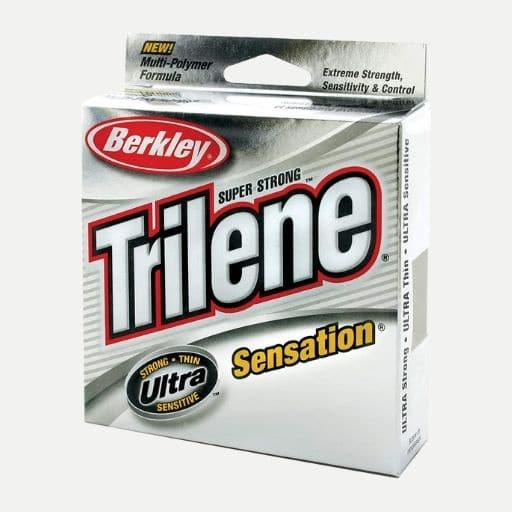
Here’s something interesting – my #3 monofilament ice fishing line, the Berkley Trilene Sensation, isn’t actually marketed for ice fishing. However, this sub-$15 line does the job perfectly for me every time.
What I like the most about it is its enhanced sensitivity. The line has less flex than typical mono, which means you feel every tiny tap or nibble.
I’ve found this really matters in the dead of winter. When fish get sluggish and barely tap your bait, that extra sensitivity makes the difference between going home with fish or empty-handed.
Another thing I love about this line is how it handles in the hole – it’s neutrally buoyant, which means perfect control when you’re jigging for crappie and bluegill. It’s also great for tying knots, even with cold fingers.
All in all, I think the added sensitivity makes the Berkley Trilene Sensation a great ice fishing line for trout and bass that are impacted due to colder temperatures.
Best Fluorocarbon Ice Fishing Lines
I’ve watched fluorocarbon evolve from being just a leader material to becoming a go-to main line for ice fishing. Technology has really changed the game, and now we can spool our entire reels with fluoro without any stiffness or lockup issues.
In my experience, it’s worth the upgrade from mono for four key reasons – strength, abrasion resistance, waterproof properties, and near invisibility underwater.
Here are the three fluorocarbon lines that have earned a permanent spot in my tackle box:
Berkley Trilene 100% Fluorocarbon

I’ve been testing Berkley Trilene 100% Fluorocarbon extensively on the ice, and there’s a reason it’s the most popular fluoro out there.
The 6lb test (it is available in 4 – 20lb options) has proven itself during my winter sessions – it’s totally clear with low memory, exactly what you need when the ice gets thick.
What really gets my attention is how sensitive it is. When I’m jigging, I can feel those light winter bites better than with mono because there’s less flex in the line.
Another big advantage you get with this line is the abrasion resistance. Thanks to it, jagged ice holes won’t snap the line when you’re landing fish.
In short, after putting it through countless hours on the ice, I can tell you this Berkley Trilene 100% line delivers everything you need in a fluorocarbon.
It is expensive (in the $20 – $30 range) as compared to mono but well worth the price.
Berkley Vanish Fluorocarbon

Like the Berkley Trilene Sensation, this Berkley Vanish Fluorocarbon is not marketed for ice fishing, but packs unique features that make it perfect for larger fish like walleye, pike, or muskie.
When I’m targeting these trophy fish, I load up with the heavier tests from their range of 14- to 20-pound options. The 250-yard spools give plenty of backup for those days when the big ones are snapping lines.
The unique feature of this line: it is bright gold-colored above ice, but turns completely clear underwater. This makes it super easy to see during rigging while still staying invisible to fish – helpful for anglers who struggle with spotting these nearly invisible lines.
Sufix Invisiline
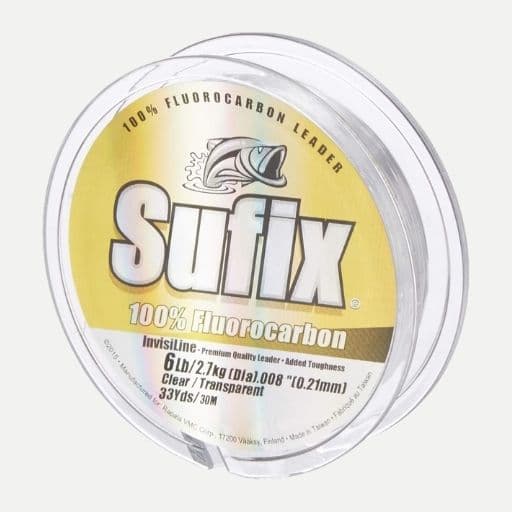
Let me tell you why the Sufix Invisiline 100% Fluorocarbon Leader has earned a spot in my ice fishing arsenal. During my testing, this hydrophobic line sank quickly and resisted abrasions like nothing else I’ve used.
Here’s something to consider: while it only comes in 33-yard spools (it’s designed as a leader), I’ve started spooling entire reels with it. I just add backing for those rare deep-water situations.
But I’ll be straight with you – this isn’t the line I’d recommend if you’re new to ice fishing. In my experience, you need solid knot-tying skills to properly connect it with backing line, and fluorocarbon has its learning curve.
Best Braided Ice Fishing Lines
Braided line on the ice is like the granddaddy of them all. However, I’ve got a love-hate relationship with it. Here’s why:
After testing different braids, I can tell you it’s incredibly sensitive and strong.
But it does come with downsides: those jagged ice holes will chew through braid faster than other lines because it’s essentially woven fabric. Plus, fish can spot it more easily underwater.
Still, plenty of successful ice anglers swear by braid. Here are the three I’ve found most reliable:
Berkley Fireline
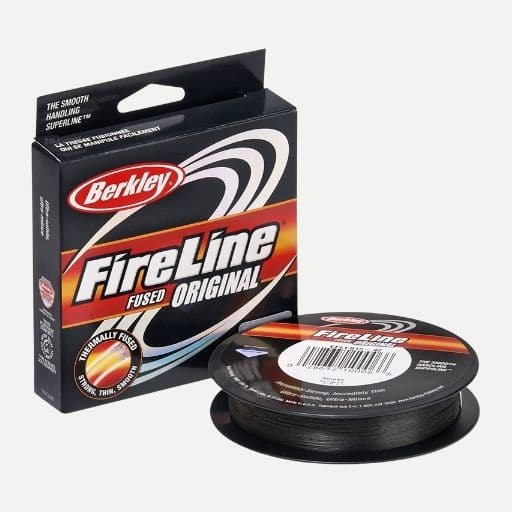
When someone asks me about braided line for ice fishing, Berkley Fireline is always my first recommendation. During a brutal day last winter, I watched other braids turn into frozen ropes while my Fireline stayed smooth and ice-free.
Here’s what impressed me most: unlike standard braids that soak up water, this line stays dry. That means no more frozen eyelets or iced-up spools – a game-changer when the temperature really drops.
While it is not the cheapest (coming at nearly $40), the sensitivity it delivers has helped me detect the lightest bites that would’ve gone unnoticed with other lines.
Sufix Ice Braid

Here’s what stands out about Sufix Ice Braid during my time on the ice: while it offers similar water-shedding properties to Fireline, its light blue color and ultra-fine diameter make it much harder for fish to spot underwater.
That said, I’ve noticed an interesting trade-off with this line: the thin diameter means less overall strength than typical braids. But, you get improved sensitivity in return.
Like other premium ice braids, it resists freezing when the temperature drops. Overall, Sufix is another solid option for ice fishing braid.
Sufix Coated Tip Up Braid

Let me share something unique about this Sufix Coated Tip Up Braid: its Hydro Fusion coating changed how I fish with tip-ups. During my testing, I’ve watched this line sink faster and handle the cold better than standard braids.
Here’s why that matters for tip-up fishing: when you’re waiting for that flag to pop, you need a line that stays sensitive and won’t absorb a lot of water. I’ve found this coated line delivers exactly that.
But I’ll be straight with you – don’t try spooling this on your regular ice reel. The stiff, waxy coating that makes it perfect for tip-ups can cause problems with your reel.
Understanding the Three Types of Line
I touched on this a little throughout but I wanted to dedicate an entire section of this guide to the three types of line. You need to understand the advantages and disadvantages of each to best understand how to choose one over the other.
Remember that in ice fishing, little things like fishing hooks, lines, and even your boots can make a big difference in how your fishing experience goes. Let’s discuss the different types of lines and how they can impact your ice fishing.
Monofilament
Mono is the most common and popular line for a reason. It’s easy to use, great for casting, has low visibility, and is relatively sensitive. You’ll find tons of this line anywhere you go whether it’s online or in the store.
This type of line is very stretchy which has some pros and cons. When a line is stretchy it means that it’ll be able to take more stress if you push it past the weight it’s rated for. But, the extra flexibility means that you won’t feel as many nibbles and it can make hook setting harder.
Monofilament isn’t known for being the most sensitive but it’s a solid middle-ground type of line that you can use in a variety of situations.
Fluorocarbon
There was a time when fluorocarbon was reserved entirely for leaders because it was too stiff. Nowadays, manufacturing has improved and fluorocarbon is flexible enough to spool an entire reel with.
The main reason people turn to fluorocarbon when it comes to ice fishing is that it is low visibility. When you’re ice fishing, especially in the middle of the season, water clarity is very high. There isn’t any rain or mud getting into the water and nothing is really stirring it up.
As a result, fish can see everything. Add that to the fact that they’re a bit timider because of the cold weather and you’ve got yourself a tough fishing situation.
Basically what I’m saying is that it’s a lot easier to spook the fish right now so you need to take all the necessary steps you can to ensure you don’t scare them. Having a line that they can’t see will make your lure more enticing and increase the chances of getting a strike.
Braided
Braided line is considered the strongest and most “premium” line out there. It has its place in ice fishing because it’s incredibly sensitive and durable. Since braided line has zero stretch, it means that you’ll get better bite detection in cold conditions.
On the other hand, braided line isn’t the best for abrasion resistance because it’s made by weaving a bunch of fiber strands together. As you’re running that line up against the edge of your hole over and over, the strands will begin to break up making the line weak.
Another downside to the braided line is the visibility factor. This line generally has a wider diameter and color that makes it more visible in the water.
Overall, braided isn’t my favorite choice for ice fishing but some of the recommendations above like the Fireline have features that make it a better choice than your “run of the mill” braided line.
Frequently Asked Questions
What pound test for ice fishing?
I’d suggest going with a 3-6 pound test in most cases. If you’re fishing for muskie or pike you will want to go much higher to around 15-20 because they’ll bite through it.
Is monofilament better than fluorocarbon for ice fishing?
I wouldn’t say that one is better than the other because it depends on too many factors. Monofilament is best for beginners but it really depends on what specific line you buy.
What color of line is best for ice fishing?
Blue is the best color for ice fishing. It’s not as difficult to work with as clear and it still offers low visibility in the water.
Should I use a leader when ice fishing?
My belief is that you should only use a fluorocarbon leader if you’re fishing for pike and muskie. These fish have a habit of biting through the line. I’d actually suggest a wire leader specifically for pike because their teeth will chew through a lot of monofilament and fluorocarbon.
Final Thoughts
I hope you got a lot out of this fishing line review and you can now choose the best ice fishing line for your needs. If you’re just starting out, you don’t need to think too hard about it, it’s just a line. Go with the Sufix Ice Magic and call it a day.
If you want to step up your game a little and try something different, you could use the Berkley Fireline.
I’d suggest picking up a few different options and trying them. Get a mono, fluoro, and braided option. None of them are that expensive and it’ll allow you to feel the difference for yourself.
Good luck out there!

